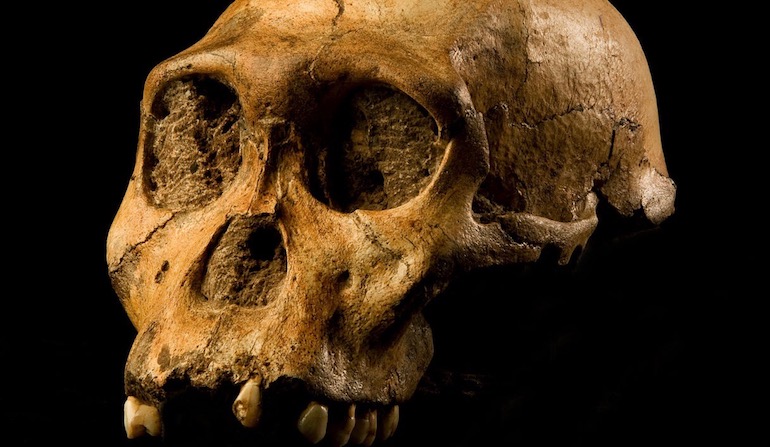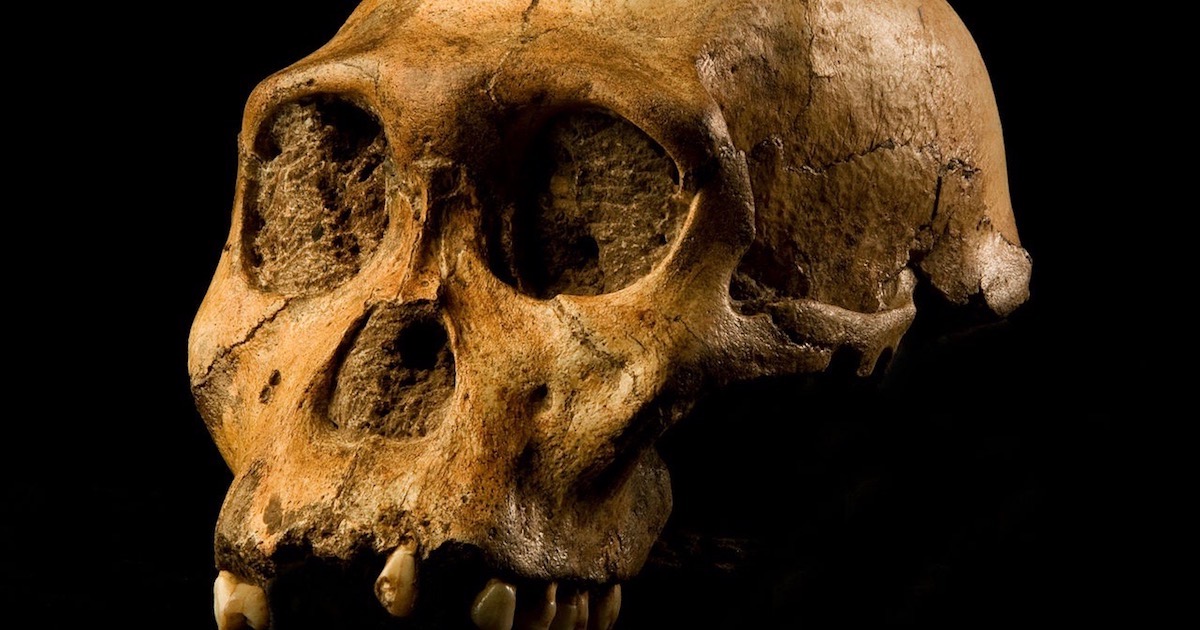 Human Origins
Human Origins
Another Human Ancestor “Falsified”: Study Puts Australopithecus sediba Back in the Ground


Since its discovery in 2010, we’ve heard claims that the fossil hominid species Australopithecus sediba is a likely ancestor of our genus Homo. Some paleoanthropologists quickly criticized those claims because sediba postdates the earliest known fossils belonging to Homo. The chronological quandary is not small, as A. sediba is about 800,000 years younger than the first known specimen of its supposed descendant, early Homo.
For proponents of sediba, however, this objection didn’t matter much. After all,one can always invent “ghost lineages” — spans of time for which a species existed, but isn’t found due to the incompleteness of the fossil record. For example, when a 2.8 million year old jaw bone was discovered belonging to Homo, sediba-advocates fell back to the old incompleteness argument:
“The idea that [the new jaw] makes anything else unlikely to be an ancestor is ludicrous,” says [Fred Grine at Stony Brook University]. “That would pretend that the fossil record is complete. And we know it can’t be, since they just discovered something that wasn’t there before.”
For years this excuse seemed enough to deflect criticisms of A. sediba’s claim to human ancestry. As a technical article stated last year:
On temporal grounds alone one cannot dismiss the possibility that A. sediba could be ancestral to the genus Homo.
But how far can that excuse go?
Dumb and Dumber
As the movie Dumb and Dumber taught the world, there’s a difference between being mathematically possible and mathematically plausible. Now, a new paper in Science Advances, “Temporal evidence shows Australopithecus sediba is unlikely to be the ancestor of Homo,” has used an innovative statistical chronological approach to definitively show that A. sediba is “falsified” as an ancestor of Homo. In fact, they conclude that there is less than a 0.1 percent chance that A. sediba is a human ancestor:
[I]t is highly unlikely that A. sediba is ancestral to Homo, and the most viable candidate ancestral species remains Australopithecus afarensis. … The computed probabilities are equivalent to P values, and if they are exceptionally low, this would suggest that A. sediba is unlikely to be the ancestor of Homo (i.e., the null hypothesis is falsified). … When the mean and SD of the 28 observed age differences are used to generate a normal distribution model (bell curve in Fig. 4), 0.8 Ma falls in the >99.9th percentile, which translates to a P value less than 0.001. … We have demonstrated using probability models that the null hypothesis of A. sediba being ancestral to Homo can be falsified. That is, it is very unlikely (about 0.09% on average) to find an A. sediba fossil horizon that is at least 0.8 Ma younger than an earliest Homo horizon, if the former species is actually ancestral to the latter.
In other words, statistically speaking, A. sediba can’t be the ancestor of early Homo.
How’d They Do It?
How did they arrive at this conclusion? First, they observed that if Species A is ancestral to Species B (in the sense allowed by budding cladogenesis, where one species splits off from another, but the parent species continues to exist), then Species A must predate Species B. Seems simple enough — after all, parents must always be older than their children! But the fossil record is incomplete, so we may not always see ancestors first appearing before their descendants. The authors thus ask: If Species A is in fact ancestral to Species B, what is the likelihood that Species A will first appear in the record a given amount of time after the first appearance of B? If we assume a uniform probability of finding a fossil species at any point during its temporal range, then the longer that Species A first appears after the first appearance of Species B, the less likely that it is ancestral to B.
Let’s now add in some numbers that relate to this specific problem.
Eight hundred thousand years separate the first appearance of early Homo from the first appearance of A. sediba. If A. sediba is ancestral to Homo then it must have existed at least 800,000 years earlier than we first find it in the fossil record. The paper puts it this way:
Given the large amount of time separating the fossil horizons of A. sediba and earliest Homo, there must have been substantial overlap between the two species’ temporal ranges, such that the end of the A. sediba range is able to postdate the beginning of the earliest Homo range by at least 0.8 Ma.
The more their ranges overlap, the more likely it is that we would sample only the end of sediba’s range and only the beginning of early Homo’s range, such that Homo appears to exist much earlier than A. sediba, even though it really didn’t. But how much overlap is there between the ranges of sediba and Homo, and is there enough overlap to make it likely to find sediba 800,000 years after Homo, if in fact sediba predates Homo?
The Degree of Overlap
They attempt to answer question about the degree of overlap by noting that the average hominin species exists for 0.97 million years. If we assume that (a) A. sediba is ancestral to early Homo, (b) both A. sediba and early Homo existed for 0.97 million years, and (c) there was 100 percent overlap of their temporal ranges — an assumption they note “is impossible for ancestor-descendant species” but is calculated so we can determine the maximum likelihood of finding sediba 800,000 years after Homo — then the maximum probability of finding the first appearance of A. sediba so long after the first appearance of Homo is 0.016. Under any typical statistical analysis, that refutes your null hypothesis that sediba is ancestral to Homo. Here’s the diagram from the paper:

Fig. 3 from Andrew Du and Zeresenay Alemseged, “Temporal evidence shows Australopithecus sediba is unlikely to be the ancestor of Homo,” Science Advances, Vol. 5(5): eaav9038 (May 8, 2019). Copyright the authors; reprinted under Creative Commons Attribution-NonCommercial License (CC BY-NC 4.0).
The authors add more empirical data to improve their calculation. They consider the broader hominid fossil record, and observe that there is only one clear-cut case where a supposed ancestor species postdates a descendant species — but in that case the age difference is only 100,000 years. By creating a histogram of the relative timing of the first appearance of 28 presumed ancestor and descendant species, and fitting a bell curve to that histogram, they find that the likelihood that A. sediba would appear 800,000 years after early Homo, if it in fact were ancestral to early Homo, is “less than 0.001.”
Histogram and Bell Curve
Here’s their histogram and bell curve, showing the case of A. sediba and early Homo plotting very far out on the right hand tail where the vertical arrow is located:

Fig. 4 from Andrew Du and Zeresenay Alemseged, “Temporal evidence shows Australopithecus sediba is unlikely to be the ancestor of Homo,” Science Advances, Vol. 5(5): eaav9038 (May 8, 2019). Copyright the authors; reprinted under Creative Commons Attribution-NonCommercial License (CC BY-NC 4.0).
Here’s an interesting question we can now consider: Some folks have claimed that Homo naledi was ancestral to other early forms of Homo, even though geological dates on H. naledi fossils now show it lived only about 300,000 years ago. Given that early Homo first appears 2.8 million years ago, what is the probability that H. naledi is an ancestor of early Homo in light of the chart above? The time discrepancy would be about 2.5 million years, but their curve only goes out to 1 million years. So naledi’s time gap is literally off the chart. But get ready for a very tiny probability with a lot of zeros after the decimal!
This Paper Represents Progress
Given the slipperiness of cladistics, it’s not every day that we see evolutionists arguing that we can falsify a species as an ancestor of another species simply because it appears in the wrong time range. When the branching order conflicts with chronology, most cladists will simply appeal (whether explicitly or implicitly) to ghost lineages and assume that morphology reigns and chronology is irrelevant. But chronology isn’t irrelevant, because, as noted, a parent can never be younger than its child! This innovative statistical approach makes for a nice case-closed argument against their cladistics-bias, as one of the authors was quoted saying:
One can disagree about morphology and the different features of a fossil, but the level of confidence we can put in the mathematical and statistical analyses of the chronological data in this paper makes our argument a very strong one.
It’s happily shocking to see this paper make the reasonable point that “Hypothesized ancestor-descendant relationships must satisfy both temporal and morphological criteria” and conclude: “Our analyses demonstrate that strong inferences can be made even with an incomplete fossil record, so chronological data and tests should not be so quickly discarded.”
The message is spreading. Gizmodo even ran the headline, “New Analysis Debunks Controversial Claim About the Origin of Humanity” — namely the claim that A. sediba was our ancestor. They quoted another paleoanthropologist as follows:
Fred Spoor, a professor at the Centre for Human Evolution Research (CHER) at the Natural History Museum in London who’s not affiliated with the new research, said the paper is important because “it statistically tests unsubstantiated headline claims” made about A. sediba.
“It’s good to see that detailed statistical analyses confirm what always seemed common sense; that it is really rather unlikely that Australopithecus sediba was directly ancestral to the genus Homo,” Spoor told Gizmodo in an email.
One hopes that in the future more weak and slippery cladistics arguments will finally be refuted when they badly contradict chronology!
Photo: Australopithecus sediba, by Brett Eloff. Courtesy Profberger and Wits University who release it under the terms below: [CC BY-SA 4.0], via Wikimedia Commons.
